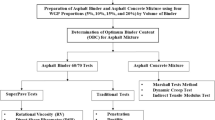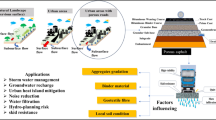Abstract
Bituminous binders have significant effect on the overall performance of the asphalt mixtures, although binders are not the main component of the asphalt mixture (4–6% by weight). This paper presents an overview of research efforts undertaken to evaluate the sensitivity of asphalt mixture performance to the change of the binder suppliers in the State of Arizona. The binders used in the asphalt mixture have identical Performance Grade (PG). However, the binders were from different suppliers. The laboratory testing program included the dynamic modulus and the repeated load/flow number tests. Asphalt mixtures were collected from four sections on a project constructed in northern Arizona. This project was unique in that all four asphalt concrete mixtures had the same aggregate structure and source but used PG 76-16 binders obtained from four different suppliers. Based on the test results, the tests were sensitive to variations in the properties of the same PG binders obtained from different suppliers. This was also confirmed through statistical analysis and comparison with the binder test data. In order to assess the sensitivity of the four asphalt binders on the pavement performance, the binder and mixture data were input into the Mechanistic-Empirical Pavement Design Guide (MEPDG) and design simulations were run to compare rutting and fatigue cracking associated with each of the four PG76-16 binders included in this study. Significant statistical differences in both distress mechanisms were also observed for the different mixtures with changing only the binder supplier.
Similar content being viewed by others
References
D. Anderson, J. Youtcheef, M. Zupanick, Asphalt Binders. Committee on Characteristics of bituminous Materials Chair, 1993. Last Retrieved July 20, 2011, from http://onlinepubs.trb.org/Onlinepubs/millennium/00006.pdf.
D. A. Anderson, D.W. Christensen, H. U. Bahia, Dongre, R. N., Sharma, M. G., Antle, C. E. and Button, J. Binder Characterization and Evaluation. SHRP A-369. Vol. 3, Physical Characterization. Strategic Highway Research Program, National Research Council, Washington, D.C. 1994.
D. A. Anderson, T. Kennedy, Development of SHRP Binder Specification. Proceedings of the Association of Asphalt Paving Technologists 62 1993 481–507.
D. A. Anderson, D.W. Christensen, H. U. Bahia, R. N. Dongre, M. G. Sharma, C. E. Antle, J. Button, C.J. Glover, Binder Characterization and Evaluation. SHRP A-370. Vol. 4. Test Methods. Strategic Highway Research Program, National Research Council, Washington, D.C. 1994.
Asphalt Institute. Binder Specification and Testing. Superpave Series SP-1. Lexington, KY, 1997.
M.W. Witczak, R. Bonaquist, H. Von Quintus, K. Kaloush, Specimen Geometry and Aggregate Size Effects in Uniaxial Compression and Constant Height Shear Tests, Journal of the Association of Asphalt Paving Technologists 69 (2000) 733–793.
Transportation Research Board Executive Committee 2005, Superpave Performance by Design. Final report, 2005. accessed at: www.trb.org/publications/sp/superpave.pdf. Accessed July 15th, 2011.
M.W. Witczak, K. Kaloush, T. Pellinen, M. El-Basyouny, H. Von Quintus, “Simple Performance Test for Superpave Mix Design”, NCHRP Report 465, National Cooperative Highway Research Program, Transportation Research Board, Washington D.C., 2002.
American Association of State Highway and Transportation Officials, Standard Method of Test for Determining Dynamic Modulus of Hot-Mix Asphalt Concrete Mixtures. AASHTO T342. AASHTO Provisional Standards, Washington, D.C., USA, 2007.
ARA, Inc., ERES Consultants Division. Guide for Mechanistic-Empirical Design of New and Rehabilitated Pavement Structures. NCHRP Project 1-37A, Final Report. Applied Research Associates, Inc., ERES Consultants Division. 2004.
B.V. Kok, N. Kuloglu, The effect of different binders on mechanical properties of hot mix asphalt. Inter. J. Sci. Tech. 2 (2008) 41–48.
I. Hafeez, et al. Performance prediction of hot mix asphalt from asphalt binders. Pakistan Journal of Engineering and Applied Sciences 11 (2012) 104–113.
A.J. Hanz, H.U. Bahia, Asphalt binder contribution to mixture workability and application of asphalt lubricity test to estimate compactability temperatures for warm-mix asphalt. Transp. Res. Rec. 2371 (2013) 87–95.
F. Moreno-Navarro, M. Sol-Sánchez, A. J. del Barco, M.C. Rubio-Gámez, Analysis of the influence of binder properties on the mechanical response of bituminous mixtures, Inter. J. Pave. Eng. 18 (1) (2017) 73–82.
W.A. Zeiada, K.E. Kaloush, S.B. Underwood, M.S. Mamlouk. Effect of Air Voids and Asphalt Content on Fatigue Damage Using the Viscoelastic Continuum Damage Analysis. Airfield and Highway Pavement Conference, Los Angeles, California, 2013.
W.A. Zeiada, K.E. Kaloush, S.B. Underwood, M.S. Mamlouk. Improved Method to Consider Air Void and Asphalt Content Changes on Long-Term Performance of Asphalt Concrete Pavements, Inter. J. Pave. Eng. 15 (8) 2013 718–730.
H. Soenen, C. De la Roche, P. Redeluis, Predict mix fatigue tests from binder fatigue properties, measured with a DSR. In Proceedings of the 3rd Eurasphalt and Eurobitumen Congress, 2. Vienna, 2004, 1924–1934.
F. Zhou, W. Mogawer, H. Li, A. Andriescu, A. Copeland, Evaluation of fatigue tests for characterizing asphalt binders. J. Mater. Civil Eng. 25 (2013) 610–617.
European Committee for Standardization, BS EN 12697-12 Bituminous mixtures. Test methods for hot mix asphalt, Part 12 Determination of the Water Sensitivity of Bituminous Specimens, British Standards Institution, London, UK, 2008.
European Committee for Standardization, BS EN 12697-22 Bituminous mixtures. Test methods for hot mix asphalt, Part 12 Wheel Tracking, British Standards Institution, London, UK, 2002.
A. Gogula, M. Hossain, J. Boyer, S. Romanoschi, “Effect of PG Binder Grade and Source on Performance of Superpave Mixtures under Hamburg Wheel Tester,” Proceedings of the 2003 Mid-Continent Transportation Research Symposium, Iowa State University, Ames, Iowa, 2003.
R. Dongré, The Effect of PG Grade Uniformity of Asphalt Binder on Pavement Performance. Report No. UT-07.08, Submitted to Utah Department of Transportation, Research and Innovation Division, Dongre Laboratory Services Inc. 2821Q Dorr Avenue Fairfax, VA — 22031, September 2007.
H. U. Bahia, D.A. Anderson, The SHRP Binder Rheological Parameters Why Are They Required and How Do They Compare to Conventional Properties. Transp. Res. Rec. 950793 (1995).
Roberts K. Brown, Kandhal, Hot Mix Apshalt Materials, Mixture Design, and Construction, 2nd Edition. NAPA Education Foundation, Lanham, Maryland, 1996.
D. Mongomery, G. Runger, Applied Statistics and Probability for Engineers. John Wiley & Sons Inc., 3rd Edition, NY, 2003
Author information
Authors and Affiliations
Corresponding author
Additional information
Peer review under responsibility of Chinese Society of Pavement Engineering.
Rights and permissions
About this article
Cite this article
Souliman, M., Zeiada, W.A., Arab, M. et al. Effect of asphalt binders with identical PG grading from different suppliers on the laboratory performance of asphalt mixture. Int. J. Pavement Res. Technol. 12, 117–124 (2019). https://doi.org/10.1007/s42947-019-0015-2
Received:
Revised:
Accepted:
Published:
Issue Date:
DOI: https://doi.org/10.1007/s42947-019-0015-2




